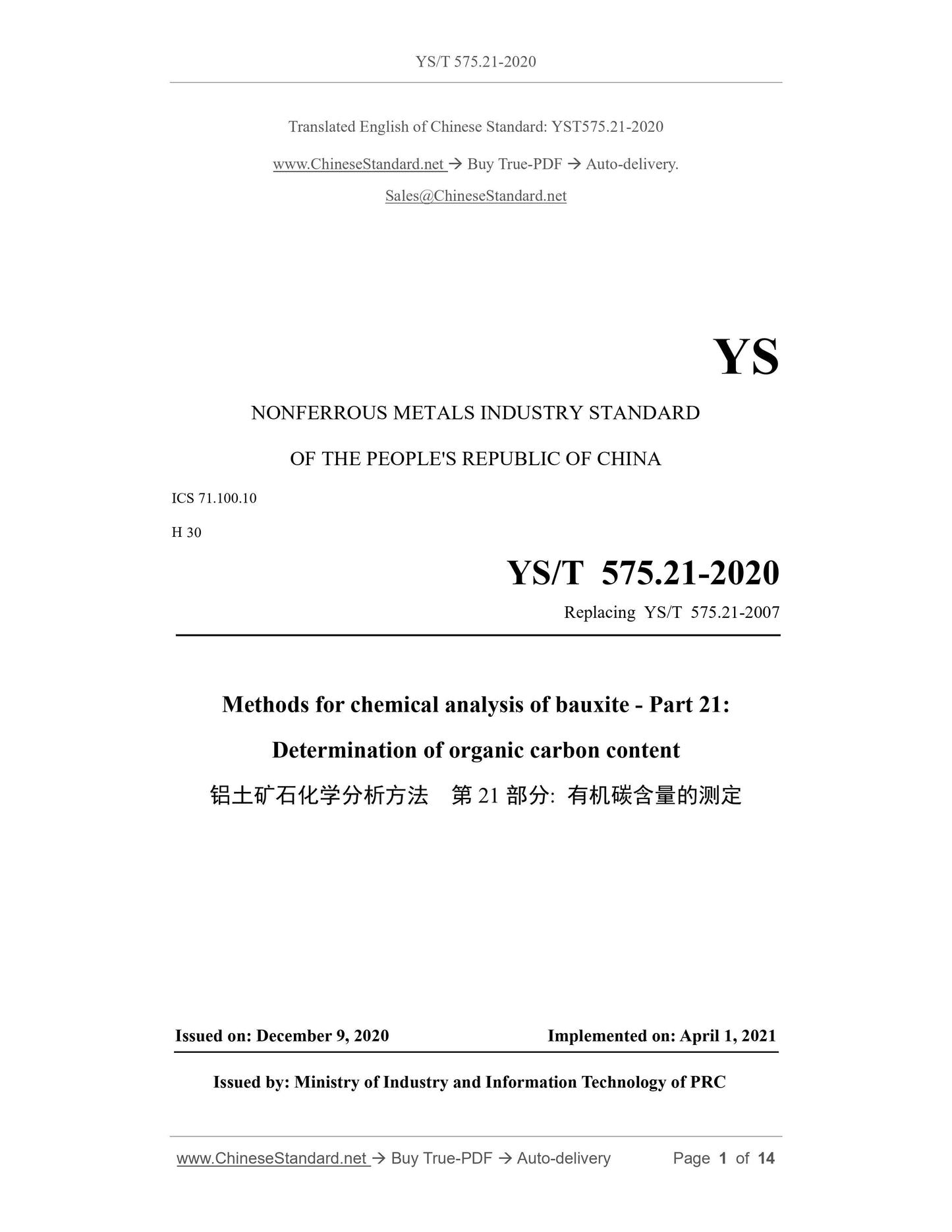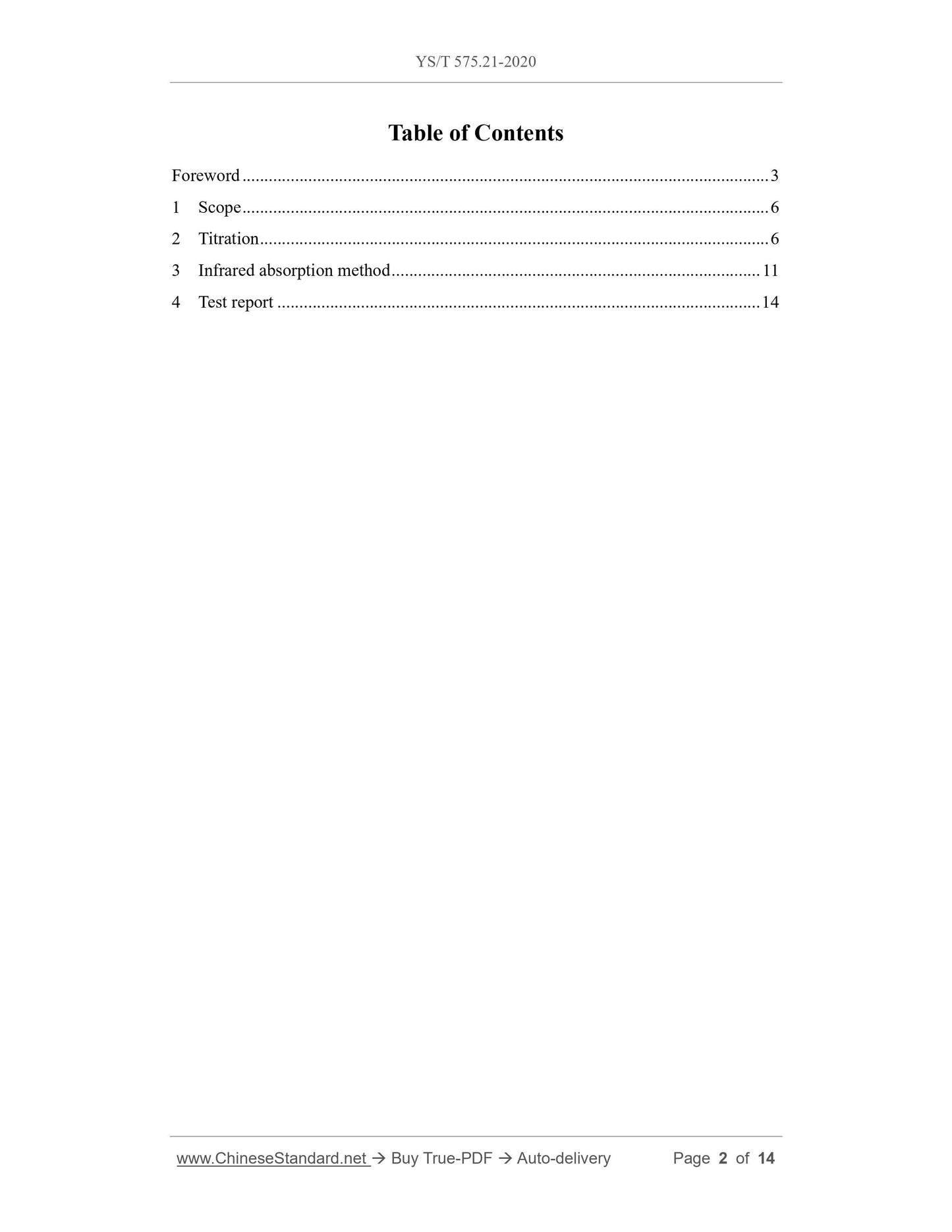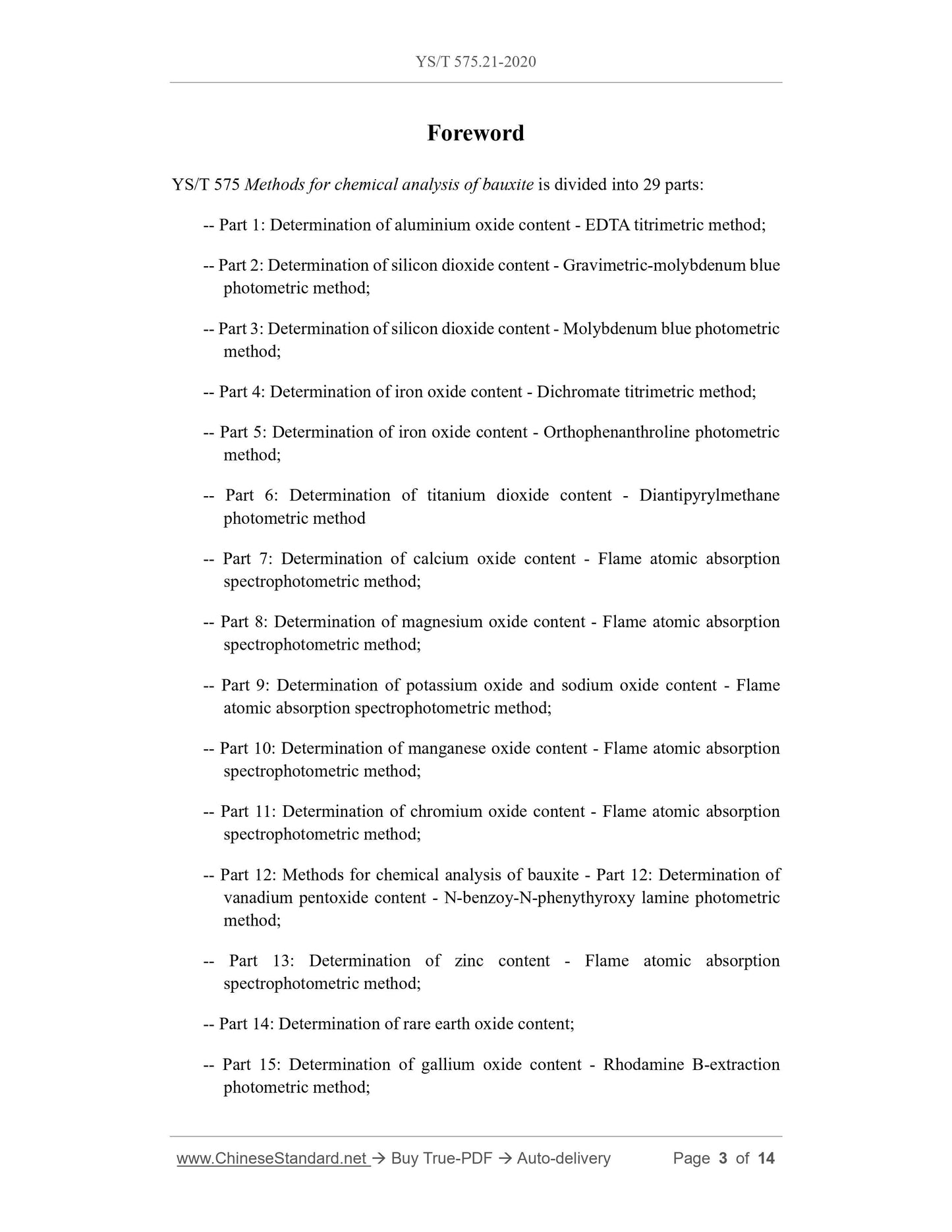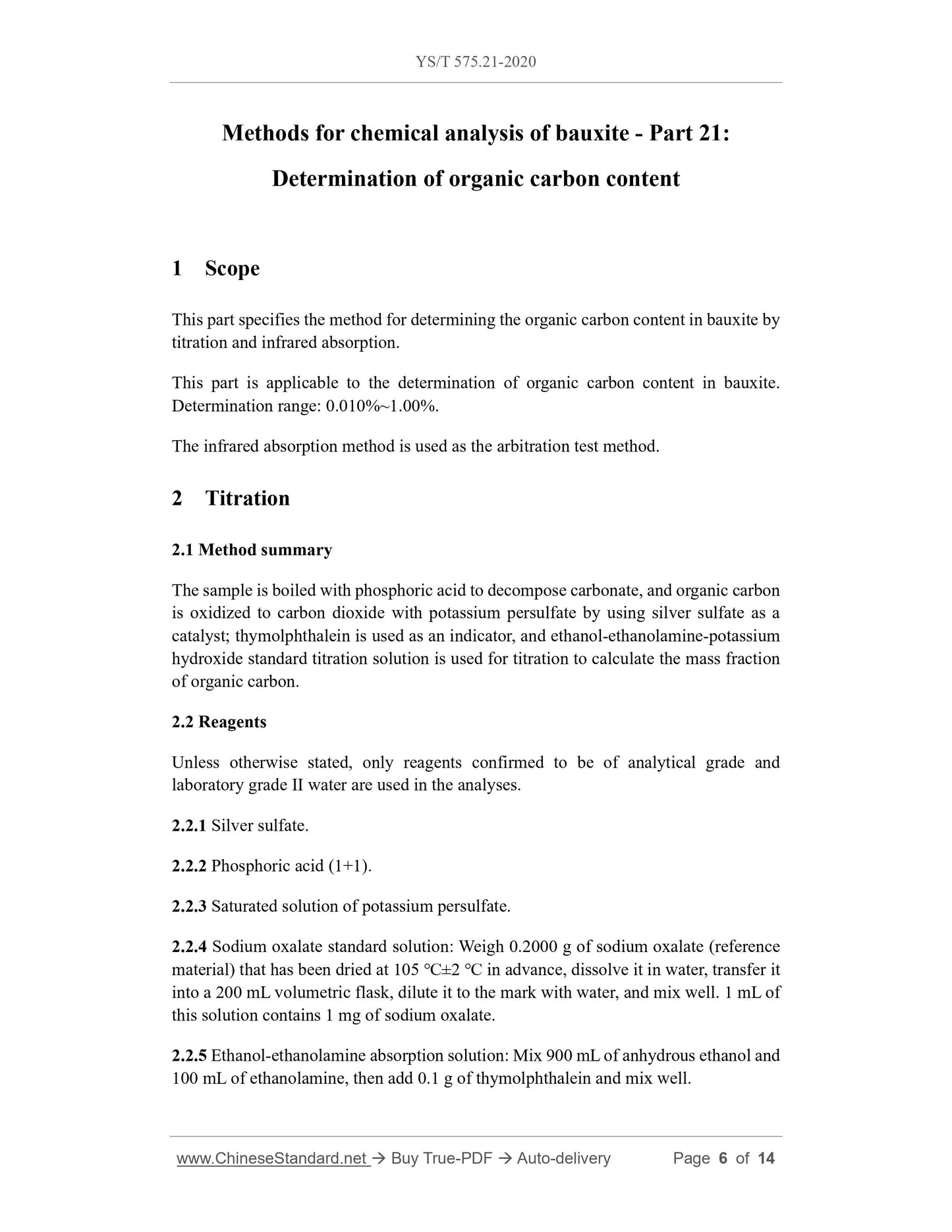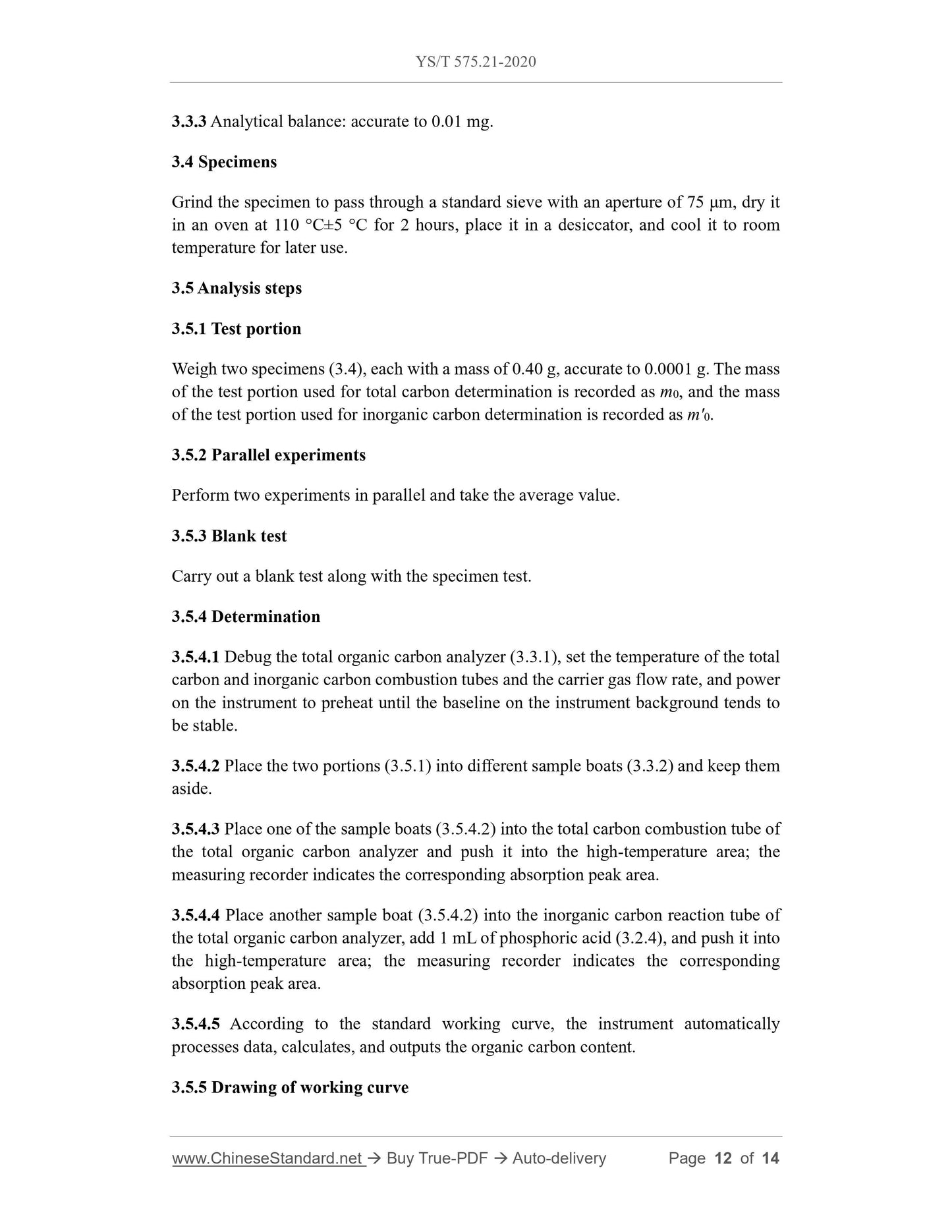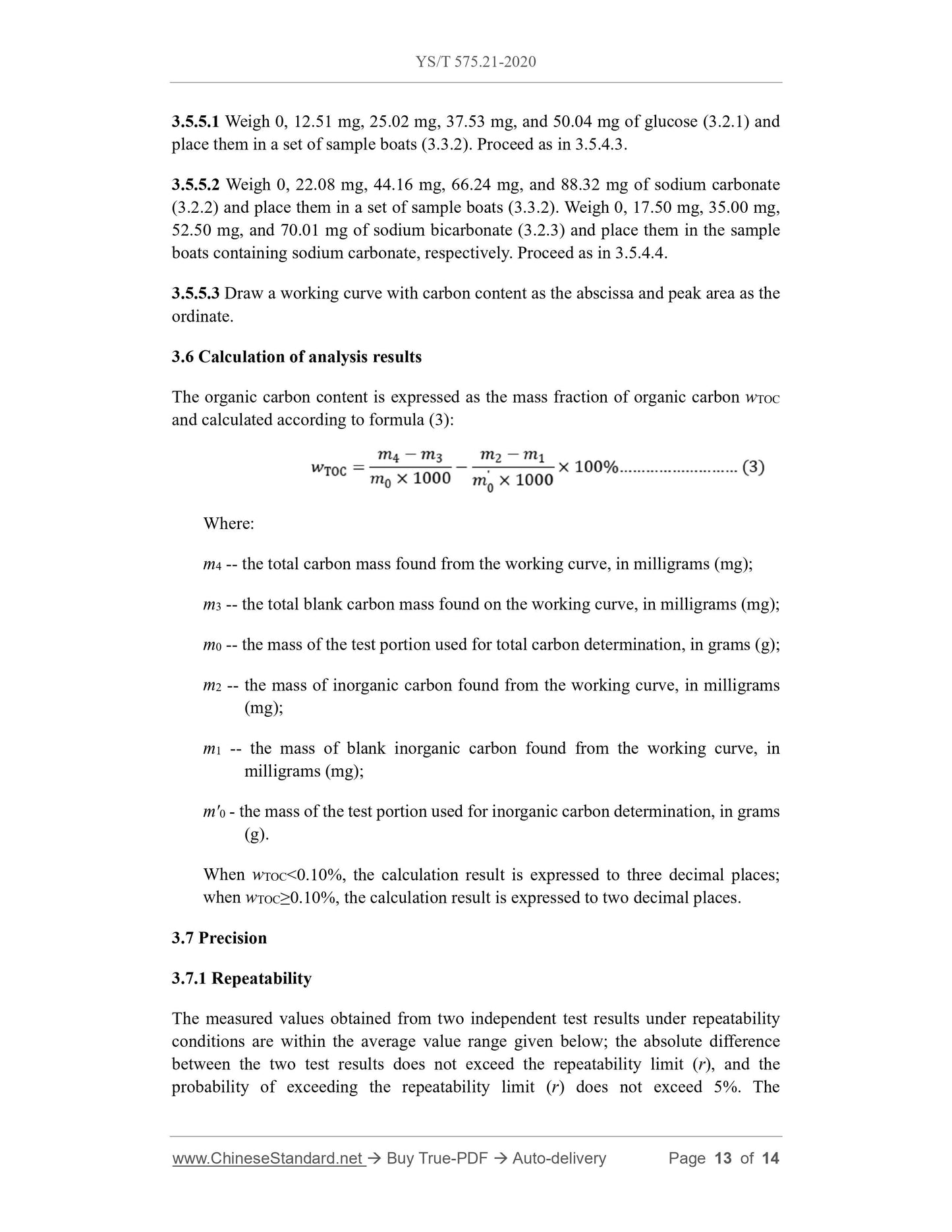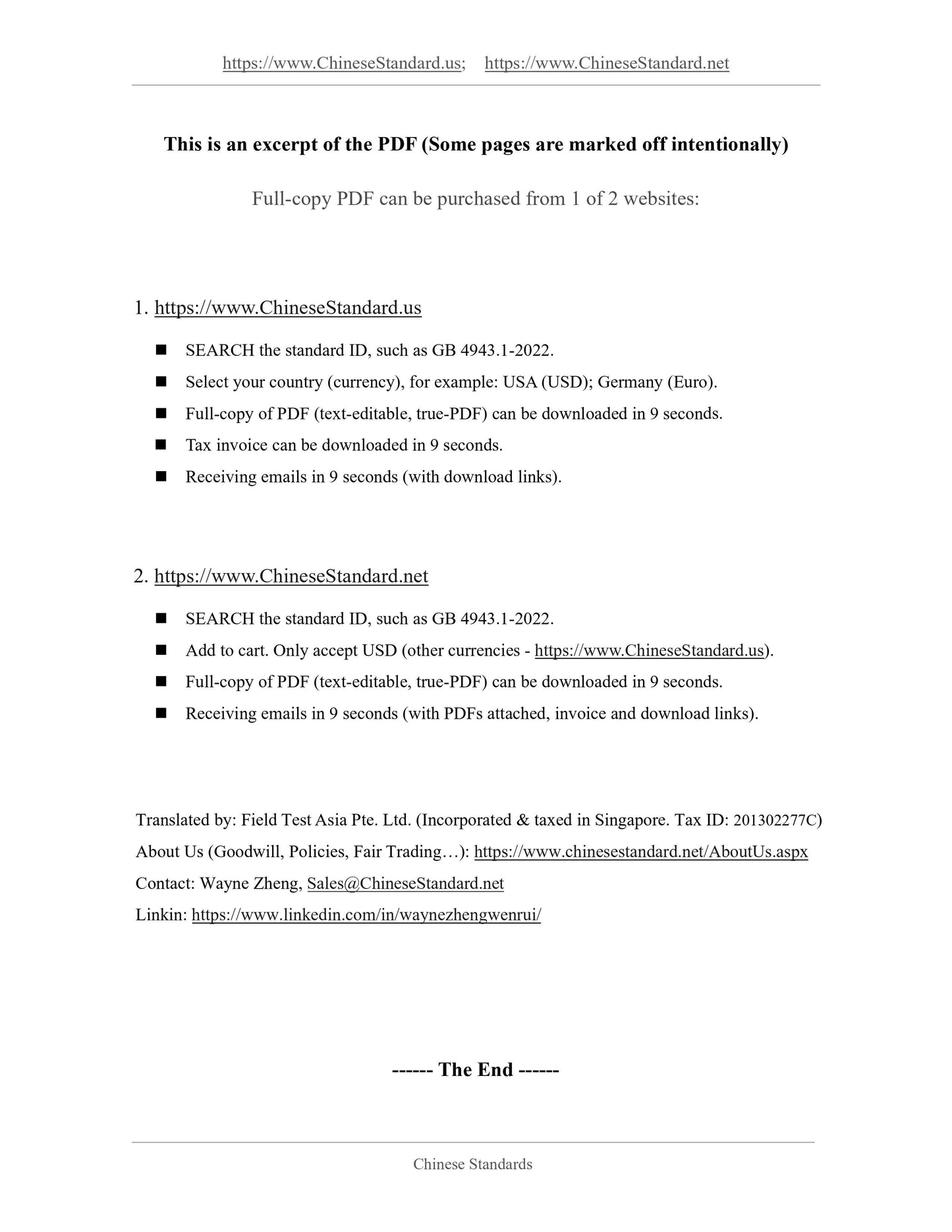1
/
av
7
PayPal, credit cards. Download editable-PDF and invoice in 1 second!
YS/T 575.21-2020 English PDF (YST575.21-2020)
YS/T 575.21-2020 English PDF (YST575.21-2020)
Ordinarie pris
$140.00 USD
Ordinarie pris
Försäljningspris
$140.00 USD
Enhetspris
/
per
Frakt beräknas i kassan.
Det gick inte att ladda hämtningstillgänglighet
Delivery: 3 seconds. Download true-PDF + Invoice.
Get Quotation: Click YS/T 575.21-2020 (Self-service in 1-minute)
Historical versions (Master-website): YS/T 575.21-2020
Preview True-PDF (Reload/Scroll-down if blank)
YS/T 575.21-2020: (Chemical analysis methods of bauxite ores. Part 21: Determination of organic carbon content)
YS/T 575.21-2020
YS
NONFERROUS METALS INDUSTRY STANDARD
OF THE PEOPLE'S REPUBLIC OF CHINA
ICS 71.100.10
H 30
Replacing YS/T 575.21-2007
Methods for chemical analysis of bauxite - Part 21:
Determination of organic carbon content
ISSUED ON: DECEMBER 9, 2020
IMPLEMENTED ON: APRIL 1, 2021
Issued by: Ministry of Industry and Information Technology of PRC
Table of Contents
Foreword ... 3
1 Scope ... 6
2 Titration ... 6
3 Infrared absorption method ... 11
4 Test report ... 14
Foreword
YS/T 575 Methods for chemical analysis of bauxite is divided into 29 parts:
-- Part 1: Determination of aluminium oxide content - EDTA titrimetric method;
-- Part 2: Determination of silicon dioxide content - Gravimetric-molybdenum blue
photometric method;
-- Part 3: Determination of silicon dioxide content - Molybdenum blue photometric
method;
-- Part 4: Determination of iron oxide content - Dichromate titrimetric method;
-- Part 5: Determination of iron oxide content - Orthophenanthroline photometric
method;
-- Part 6: Determination of titanium dioxide content - Diantipyrylmethane
photometric method
-- Part 7: Determination of calcium oxide content - Flame atomic absorption
spectrophotometric method;
-- Part 8: Determination of magnesium oxide content - Flame atomic absorption
spectrophotometric method;
-- Part 9: Determination of potassium oxide and sodium oxide content - Flame
atomic absorption spectrophotometric method;
-- Part 10: Determination of manganese oxide content - Flame atomic absorption
spectrophotometric method;
-- Part 11: Determination of chromium oxide content - Flame atomic absorption
spectrophotometric method;
-- Part 12: Methods for chemical analysis of bauxite - Part 12: Determination of
vanadium pentoxide content - N-benzoy-N-phenythyroxy lamine photometric
method;
-- Part 13: Determination of zinc content - Flame atomic absorption
spectrophotometric method;
-- Part 14: Determination of rare earth oxide content;
-- Part 15: Determination of gallium oxide content - Rhodamine B-extraction
photometric method;
Methods for chemical analysis of bauxite - Part 21:
Determination of organic carbon content
1 Scope
This part specifies the method for determining the organic carbon content in bauxite by
titration and infrared absorption.
This part is applicable to the determination of organic carbon content in bauxite.
Determination range: 0.010%~1.00%.
The infrared absorption method is used as the arbitration test method.
2 Titration
2.1 Method summary
The sample is boiled with phosphoric acid to decompose carbonate, and organic carbon
is oxidized to carbon dioxide with potassium persulfate by using silver sulfate as a
catalyst; thymolphthalein is used as an indicator, and ethanol-ethanolamine-potassium
hydroxide standard titration solution is used for titration to calculate the mass fraction
of organic carbon.
2.2 Reagents
Unless otherwise stated, only reagents confirmed to be of analytical grade and
laboratory grade II water are used in the analyses.
2.2.1 Silver sulfate.
2.2.2 Phosphoric acid (1+1).
2.2.3 Saturated solution of potassium persulfate.
2.2.4 Sodium oxalate standard solution: Weigh 0.2000 g of sodium oxalate (reference
material) that has been dried at 105 ℃±2 ℃ in advance, dissolve it in water, transfer it
into a 200 mL volumetric flask, dilute it to the mark with water, and mix well. 1 mL of
this solution contains 1 mg of sodium oxalate.
2.2.5 Ethanol-ethanolamine absorption solution: Mix 900 mL of anhydrous ethanol and
100 mL of ethanolamine, then add 0.1 g of thymolphthalein and mix well.
3.3.3 Analytical balance: accurate to 0.01 mg.
3.4 Specimens
Grind the specimen to pass through a standard sieve with an aperture of 75 μm, dry it
in an oven at 110 °C±5 °C for 2 hours, place it in a desiccator, and cool it to room
temperature for later use.
3.5 Analysis steps
3.5.1 Test portion
Weigh two specimens (3.4), each with a mass of 0.40 g, accurate to 0.0001 g. The mass
of the test portion used for total carbon determination is recorded as m0, and the mass
of the test portion used for inorganic carbon determination is recorded as m'0.
3.5.2 Parallel experiments
Perform two experiments in parallel and take the average value.
3.5.3 Blank test
Carry out a blank test along with the specimen test.
3.5.4 Determination
3.5.4.1 Debug the total organic carbon analyzer (3.3.1), set the temperature of the total
carbon and inorganic carbon combustion tubes and the carrier gas flow rate, and power
on the instrument to preheat until the baseline on the instrument background tends to
be stable.
3.5.4.2 Place the two portions (3.5.1) into different sample boats (3.3.2) and keep them
aside.
3.5.4.3 Place one of the sample boats (3.5.4.2) into the total carbon combustion tube of
the total organic carbon analyzer and push it into the high-temperature area; the
measuring recorder indicates the corresponding absorption peak area.
3.5.4.4 Place another sample boat (3.5.4.2) into the inorganic carbon reaction tube of
the total organic carbon analyzer, add 1 mL of phosphoric acid (3.2.4), and push it into
the high-temperature area; the measuring recorder indicates the corresponding
absorption peak area.
3.5.4.5 According to the standard working curve, the instrument automatically
processes data, calculates, and outputs the organic carbon content.
3.5.5 Drawing of working curve
3.5.5.1 Weigh 0, 12.51 mg, 25.02 mg, 37.53 mg, and 50.04 mg of glucose (3.2.1) and
place them in a set of sample boats (3.3.2). Proceed as in 3.5.4.3.
3.5.5.2 Weigh 0, 22.08 mg, 44.16 mg, 66.24 mg, and 88.32 mg of sodium carbonate
(3.2.2) and place them in a set of sample boats (3.3.2). Weigh 0, 17.50 mg, 35.00 mg,
52.50 mg, and 70.01 mg of sodium bicarbonate (3.2.3) and place them in the sample
boats containing sodium carbonate, respectively. Proceed as in 3.5.4.4.
3.5.5.3 Draw a working curve with carbon content as the abscissa and peak area as the
ordinate.
3.6 Calculation of analysis results
The organic carbon content is expressed as the mass fraction of organic carbon wTOC
and calculated according to formula (3):
Where:
m4 -- the total carbon mass found from the working curve, in milligrams (mg);
m3 -- the total blank carbon mass found on the working curve, in milligrams (mg);
m0 -- the mass of the test portion used for total carbon determination, in grams (g);
m2 -- the mass of inorganic carbon found from the working curve, in milligrams
(mg);
m1 -- the mass of blank inorganic carbon found from the working curve, in
milligrams (mg);
m'0 - the mass of the test portion used for inorganic carbon determination, in grams
(g).
When wTOC< 0.10%, the calculation result is expressed to three decimal places;
when wTOC≥0.10%, the calculation result is expressed to two decimal places.
3.7 Precision
3.7.1 Repeatability
The measured values obtained from two independent test results under repeatability
conditions are within the average value range given below; the absolute difference
between the two test results does not exceed the repeatability limit (r), and the
probability of exceeding the repeatability limit (r) does not exceed 5%. The
Get Quotation: Click YS/T 575.21-2020 (Self-service in 1-minute)
Historical versions (Master-website): YS/T 575.21-2020
Preview True-PDF (Reload/Scroll-down if blank)
YS/T 575.21-2020: (Chemical analysis methods of bauxite ores. Part 21: Determination of organic carbon content)
YS/T 575.21-2020
YS
NONFERROUS METALS INDUSTRY STANDARD
OF THE PEOPLE'S REPUBLIC OF CHINA
ICS 71.100.10
H 30
Replacing YS/T 575.21-2007
Methods for chemical analysis of bauxite - Part 21:
Determination of organic carbon content
ISSUED ON: DECEMBER 9, 2020
IMPLEMENTED ON: APRIL 1, 2021
Issued by: Ministry of Industry and Information Technology of PRC
Table of Contents
Foreword ... 3
1 Scope ... 6
2 Titration ... 6
3 Infrared absorption method ... 11
4 Test report ... 14
Foreword
YS/T 575 Methods for chemical analysis of bauxite is divided into 29 parts:
-- Part 1: Determination of aluminium oxide content - EDTA titrimetric method;
-- Part 2: Determination of silicon dioxide content - Gravimetric-molybdenum blue
photometric method;
-- Part 3: Determination of silicon dioxide content - Molybdenum blue photometric
method;
-- Part 4: Determination of iron oxide content - Dichromate titrimetric method;
-- Part 5: Determination of iron oxide content - Orthophenanthroline photometric
method;
-- Part 6: Determination of titanium dioxide content - Diantipyrylmethane
photometric method
-- Part 7: Determination of calcium oxide content - Flame atomic absorption
spectrophotometric method;
-- Part 8: Determination of magnesium oxide content - Flame atomic absorption
spectrophotometric method;
-- Part 9: Determination of potassium oxide and sodium oxide content - Flame
atomic absorption spectrophotometric method;
-- Part 10: Determination of manganese oxide content - Flame atomic absorption
spectrophotometric method;
-- Part 11: Determination of chromium oxide content - Flame atomic absorption
spectrophotometric method;
-- Part 12: Methods for chemical analysis of bauxite - Part 12: Determination of
vanadium pentoxide content - N-benzoy-N-phenythyroxy lamine photometric
method;
-- Part 13: Determination of zinc content - Flame atomic absorption
spectrophotometric method;
-- Part 14: Determination of rare earth oxide content;
-- Part 15: Determination of gallium oxide content - Rhodamine B-extraction
photometric method;
Methods for chemical analysis of bauxite - Part 21:
Determination of organic carbon content
1 Scope
This part specifies the method for determining the organic carbon content in bauxite by
titration and infrared absorption.
This part is applicable to the determination of organic carbon content in bauxite.
Determination range: 0.010%~1.00%.
The infrared absorption method is used as the arbitration test method.
2 Titration
2.1 Method summary
The sample is boiled with phosphoric acid to decompose carbonate, and organic carbon
is oxidized to carbon dioxide with potassium persulfate by using silver sulfate as a
catalyst; thymolphthalein is used as an indicator, and ethanol-ethanolamine-potassium
hydroxide standard titration solution is used for titration to calculate the mass fraction
of organic carbon.
2.2 Reagents
Unless otherwise stated, only reagents confirmed to be of analytical grade and
laboratory grade II water are used in the analyses.
2.2.1 Silver sulfate.
2.2.2 Phosphoric acid (1+1).
2.2.3 Saturated solution of potassium persulfate.
2.2.4 Sodium oxalate standard solution: Weigh 0.2000 g of sodium oxalate (reference
material) that has been dried at 105 ℃±2 ℃ in advance, dissolve it in water, transfer it
into a 200 mL volumetric flask, dilute it to the mark with water, and mix well. 1 mL of
this solution contains 1 mg of sodium oxalate.
2.2.5 Ethanol-ethanolamine absorption solution: Mix 900 mL of anhydrous ethanol and
100 mL of ethanolamine, then add 0.1 g of thymolphthalein and mix well.
3.3.3 Analytical balance: accurate to 0.01 mg.
3.4 Specimens
Grind the specimen to pass through a standard sieve with an aperture of 75 μm, dry it
in an oven at 110 °C±5 °C for 2 hours, place it in a desiccator, and cool it to room
temperature for later use.
3.5 Analysis steps
3.5.1 Test portion
Weigh two specimens (3.4), each with a mass of 0.40 g, accurate to 0.0001 g. The mass
of the test portion used for total carbon determination is recorded as m0, and the mass
of the test portion used for inorganic carbon determination is recorded as m'0.
3.5.2 Parallel experiments
Perform two experiments in parallel and take the average value.
3.5.3 Blank test
Carry out a blank test along with the specimen test.
3.5.4 Determination
3.5.4.1 Debug the total organic carbon analyzer (3.3.1), set the temperature of the total
carbon and inorganic carbon combustion tubes and the carrier gas flow rate, and power
on the instrument to preheat until the baseline on the instrument background tends to
be stable.
3.5.4.2 Place the two portions (3.5.1) into different sample boats (3.3.2) and keep them
aside.
3.5.4.3 Place one of the sample boats (3.5.4.2) into the total carbon combustion tube of
the total organic carbon analyzer and push it into the high-temperature area; the
measuring recorder indicates the corresponding absorption peak area.
3.5.4.4 Place another sample boat (3.5.4.2) into the inorganic carbon reaction tube of
the total organic carbon analyzer, add 1 mL of phosphoric acid (3.2.4), and push it into
the high-temperature area; the measuring recorder indicates the corresponding
absorption peak area.
3.5.4.5 According to the standard working curve, the instrument automatically
processes data, calculates, and outputs the organic carbon content.
3.5.5 Drawing of working curve
3.5.5.1 Weigh 0, 12.51 mg, 25.02 mg, 37.53 mg, and 50.04 mg of glucose (3.2.1) and
place them in a set of sample boats (3.3.2). Proceed as in 3.5.4.3.
3.5.5.2 Weigh 0, 22.08 mg, 44.16 mg, 66.24 mg, and 88.32 mg of sodium carbonate
(3.2.2) and place them in a set of sample boats (3.3.2). Weigh 0, 17.50 mg, 35.00 mg,
52.50 mg, and 70.01 mg of sodium bicarbonate (3.2.3) and place them in the sample
boats containing sodium carbonate, respectively. Proceed as in 3.5.4.4.
3.5.5.3 Draw a working curve with carbon content as the abscissa and peak area as the
ordinate.
3.6 Calculation of analysis results
The organic carbon content is expressed as the mass fraction of organic carbon wTOC
and calculated according to formula (3):
Where:
m4 -- the total carbon mass found from the working curve, in milligrams (mg);
m3 -- the total blank carbon mass found on the working curve, in milligrams (mg);
m0 -- the mass of the test portion used for total carbon determination, in grams (g);
m2 -- the mass of inorganic carbon found from the working curve, in milligrams
(mg);
m1 -- the mass of blank inorganic carbon found from the working curve, in
milligrams (mg);
m'0 - the mass of the test portion used for inorganic carbon determination, in grams
(g).
When wTOC< 0.10%, the calculation result is expressed to three decimal places;
when wTOC≥0.10%, the calculation result is expressed to two decimal places.
3.7 Precision
3.7.1 Repeatability
The measured values obtained from two independent test results under repeatability
conditions are within the average value range given below; the absolute difference
between the two test results does not exceed the repeatability limit (r), and the
probability of exceeding the repeatability limit (r) does not exceed 5%. The
Share
